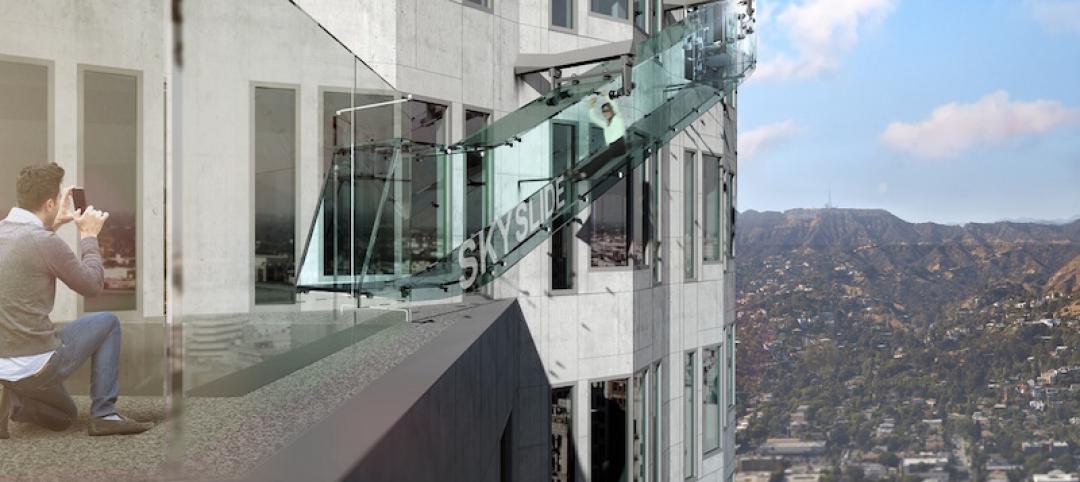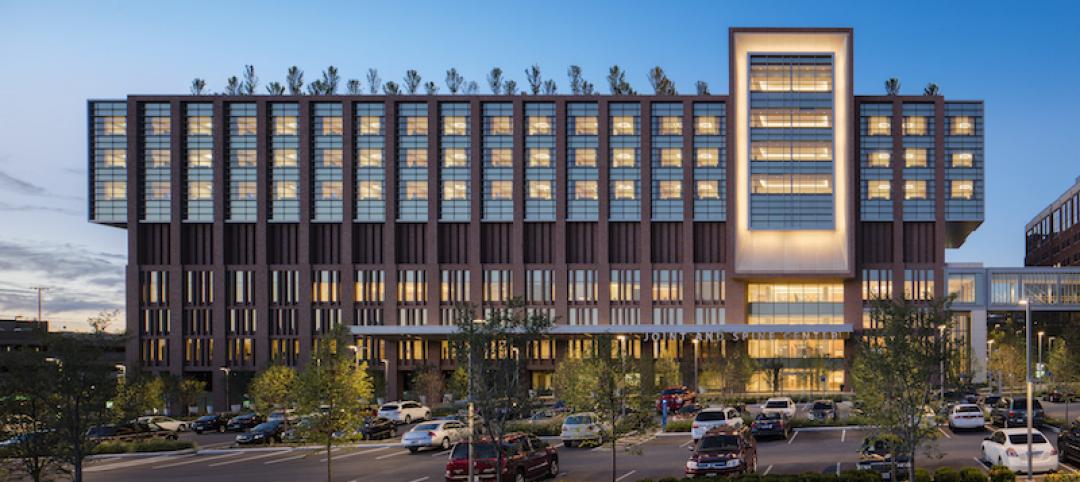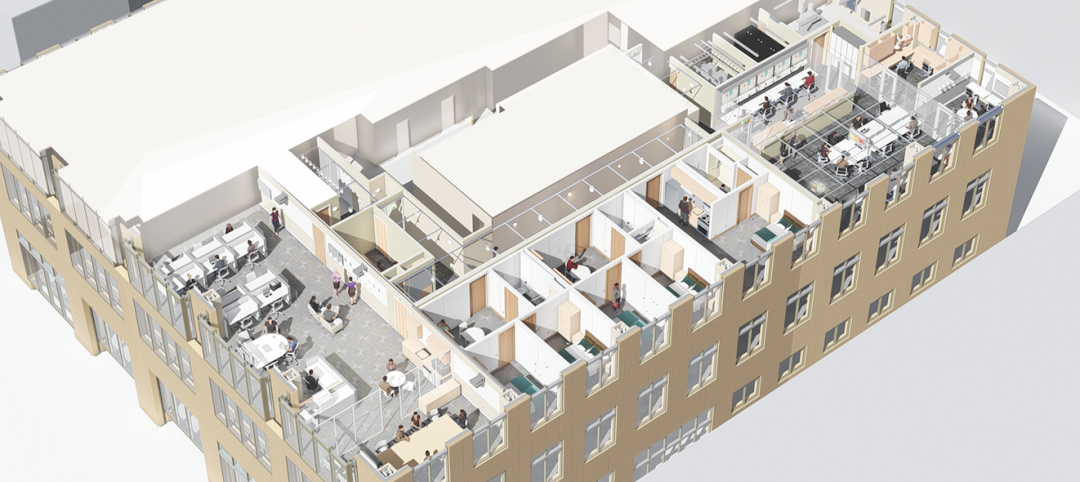 |
|
Built as an homage to the Washington Monument, Minneapolis’s funky Foshay Tower becomes the even funkier W Hotel. |
At one time the tallest building west of the Mississippi, the Foshay Tower has stood proudly on the Minneapolis skyline since 1929. Built by Wilbur Foshay as a tribute to the Washington Monument, the 30-story obelisk served as an office building—and cultural icon—for more than 70 years before the Ryan Companies and co-developer RWB Holdings partnered with Starwood Hotels & Resorts to convert the registered landmark into, of all things, a hip W Hotel.
Adaptive reuse projects are always tricky, but the building's distinctive obelisk shape complicated matters to the extent that when architects Elness Swenson Graham completed the design, there were 57 unique room configurations within the 230-room hotel. The tower loses half its floor area between the second floor and the 30th floor, dropping from 6,000 sf on the second floor to less than 3,000 sf at the top. The complex floor plates also threw MEP contractors Horwitz Inc. and Egan Companies a curve because there was no way to stack plumbing and mechanical systems. Their solution was to break the hotel into flooring groups and then make transitions between each floor set.
The Building Team also faced the high-stakes task of preserving and restoring the building's historic Art Deco lobby ceiling, marble walls, and terrazzo floors. These elements were integrated into the W's modern design aesthetic by interior design team Munge Leung Design Associates.
 |
|
The building’s tapered shape required interior designers to commission adjustable furniture that fits the hotel’s 57 different room configurations. |
On top of everything else, there was no wiggle room on the opening date, August 2008, because the Republican National Convention was being hosted in the twin city of St. Paul the following month and Starwood needed the guest rooms.
Using design-build delivery, Ryan Companies redeveloped the 268,000-sf Foshay Tower at a construction cost of $56 million. The project's final cost was $61 million after the Building Team assumed responsibility for the hotel's restaurant and retail components from the tenants.
Working in the Building Team's favor was the fact that the landmark building was structurally sound and in good shape for its age—that is, unless you ignore the fact that it was packed with asbestos. A tight timeline required asbestos remediation to begin while some office tenants were still in the building. This dictated a more complicated than usual containment system: partition systems, dedicated elevators, night work, and coordinated adjacencies. Tenants were provided generous move-out packages to expedite their exit.
Complications also arose around the building's old windows. Almost 750 units needed to be replaced, which disappointed the National Park Service, since the Foshay Tower is on the National Register of Historic Places. After considerable negotiations, the two sides agreed that replacement could proceed using custom, historically accurate, high-efficiency aluminum units.
The project greatly impressed BD+C's Reconstruction Awards judges, who appreciated the difficulties associated with adaptive reuse projects. “It is really challenging to convert an office building into a hotel,” says Lucien Lagrange, principal of Lucien Lagrange Architects, Chicago. “The Foshay project says something about adaptive reuse and the importance of saving a beautiful existing building.”

Related Stories
Hospital Design Trends | May 19, 2016
CannonDesign releases new white paper on advancements in operating room environments
"Surgical Suites: Emerging Approaches to Planning and Design" offers solutions for collaboration and technology integration.
Healthcare Facilities | Apr 29, 2016
How improving emergency department design leads to greater hospital efficiency
Efficient ED operations result in shorter wait times, quicker diagnosis and care plans, maximum utilization of high-cost human and physical resources, and overall better patient experiences and patient satisfaction scores, writes CBRE Healthcare's Curtis Skolnick.
Healthcare Facilities | Apr 24, 2016
A symposium in New Jersey examines how a consolidating healthcare industry can better manage its excess real estate
As service providers position themselves closer to their communities, they are looking for ways to redirect non-core buildings and land for other purposes.
Adaptive Reuse | Apr 7, 2016
Redevelopment plan announced for Chicago’s historic Cook County Hospital
The century-old, Beaux Arts architecture-inspired hospital will transform into a mixed-use development.
High-rise Construction | Mar 3, 2016
LA's U.S. Bank Tower to build exterior glass slide leading from 70th to 69th floors
The glass slide, part of a $50 million renovation project, will stretch 45 feet along the exterior of the building.
Healthcare Facilities | Mar 1, 2016
Christ Hospital in Cincinnati brings its joint and spine care services under one roof
The opening coincides with agreements that make this center a preferred provider for several employers with self-funded healthcare plans.
Game Changers | Feb 5, 2016
Mayo Clinic's breakthrough research lab puts evidence-based design to the test
Mayo teams up with Delos to bring hard science to EBD research.
Great Solutions | Jan 19, 2016
Healing garden doubles as therapy trails
A Boston-area hospital takes the healing garden to the next level.
Great Solutions | Jan 6, 2016
Shepley Bulfinch develops elegant design solution to address behavioral issues in emergency departments
ED scheme allows staff to isolate unruly patients and visitors in a secure area.
Greenbuild Report | Dec 10, 2015
Sustainable performance: Hospital systems’ new financial and marketing imperative
Several years ago, the healthcare industry would have ranked in the bottom tier among adopters of sustainable design and construction. Now, it is outpacing other nonresidential sectors in moving toward high-performance, healthy environments.
















